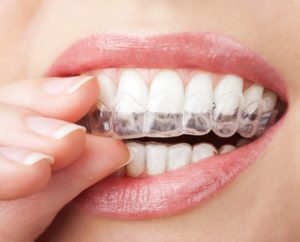Invisalign is a popular brand of clear plastic aligners. They are a convenient way to straighten your teeth without disrupting your lifestyle. Rather than traditional metal braces that need rubber bands and tightening, you will change to a new set of trays about every two weeks. This eliminates the need for painful adjustments or bulky brackets.
Many patients love the “invisible” aspect of Invisalign aligners. Because they are made of clear plastic, the aligners are difficult to see when they are on your teeth. You don’t have to worry about metal braces being the highlight of your pictures.

What Is Invisalign?
Invisalign aligners are removable, which means that you don’t have to drastically change your diet in the same way as traditional metal braces. For example, rather than avoiding gum or popcorn, you can simply remove your aligners in order to enjoy your favorite foods.
There are a variety of benefits that come with Invisalign aligners. When you decide to straighten your smile, you should talk to your dentist about this method. If you choose aligner trays, it is vital that you know how to take care of them in order to keep your teeth and trays healthy.
Clean Them Daily
Although the aligners are not a part of your teeth, they do spend a large amount of time near your teeth and gums. If the aligners are not clean, then your teeth are not clean. Even though the trays are plastic, they can still collect plaque on their surfaces.
Plaque is a type of harmful bacteria that collects on the surfaces of teeth and gums. This bacteria is responsible for causing tooth decay and gum disease. When you don’t remove plaque from your mouth or aligners, you increase your chances of developing a dental issue.
The best way to avoid cavities or gum disease is to keep your Invisalign aligners clean. Before you go to bed, remove your aligners to give them a good clean. You can clean them at any time of the day or night; however, removing plaque before bed reduces the number of bacteria on your teeth as you sleep.
Rinse Your Mouth
One way that you can minimize plaque and bad breath with aligners are to rinse your mouth with water after you eat. When you eat, you break down food into smaller particles. You frequently leave small food particles in your mouth once you finish eating.
If there is food in your mouth, you will increase the number of bacteria. This is because bacteria will eat the food particles and multiply. More bacteria means that you have a higher chance of tooth decay. Additionally, bacteria can cause bad breath.
To prevent a buildup of plaque or decaying food particles, you can rinse your mouth with water after you eat. Try swishing some water back and forth in your mouth like you would with mouthwash. Also, you can rinse your trays before placing them back in your mouth. This can eliminate food particles and plaque buildup.
